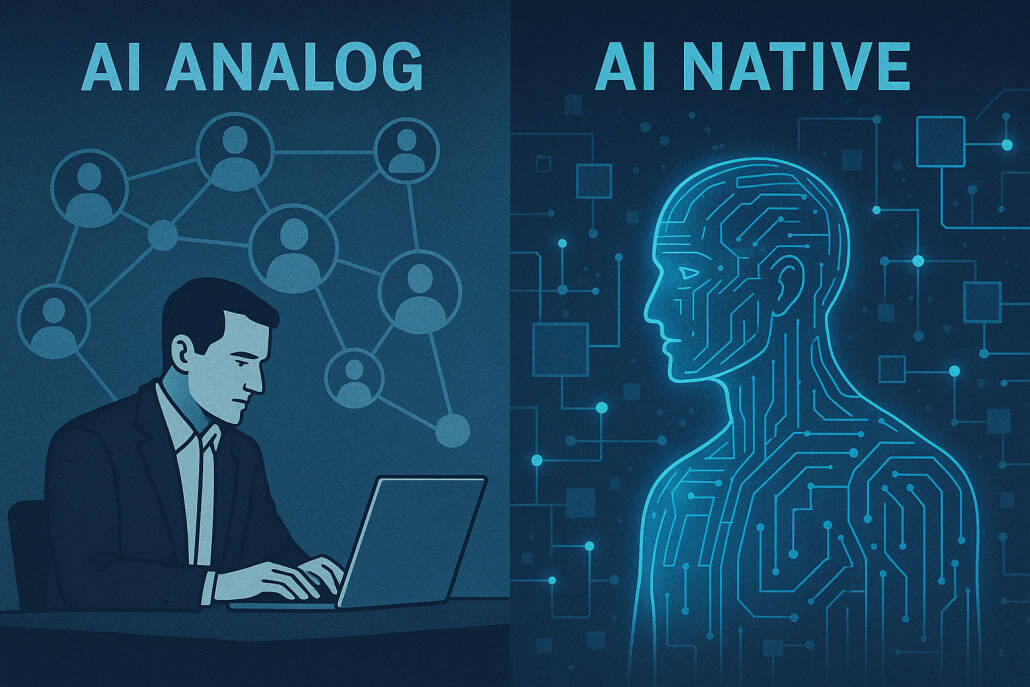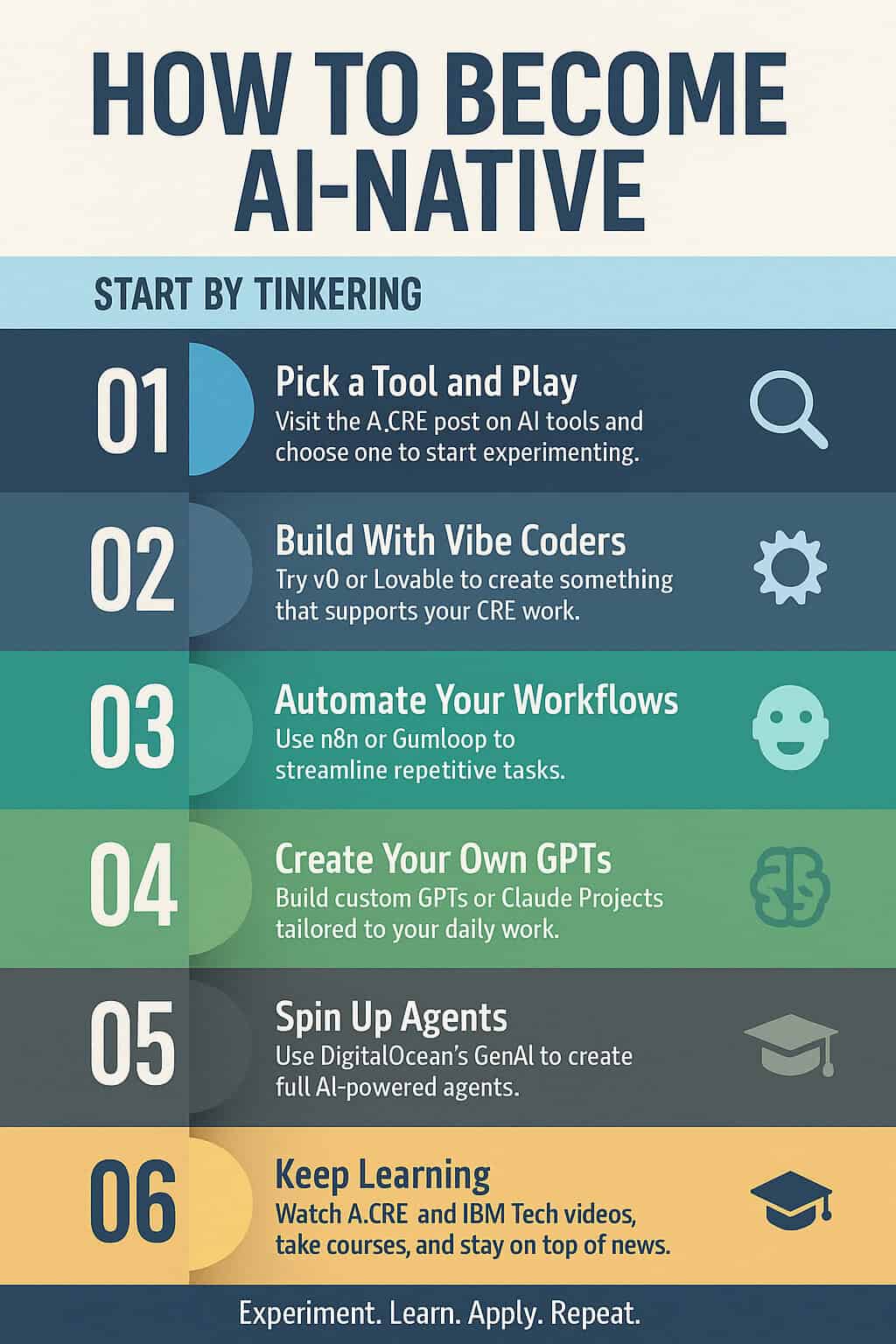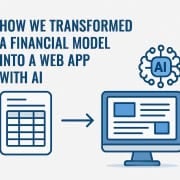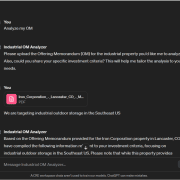From AI Analog to AI Native: My View on Where CRE Work Is Going
I thought I’d share a few thoughts that came to mind as Michael and Sam were in town recording the latest season of the A.CRE Audio Series. We spent a lot of time talking about AI – what’s real and what’s not, where it might take the industry, and how it’s already reshaping our work.
Most of us in commercial real estate are still working in what I’d call an “AI Analog” environment. It’s the world we know where humans drive the work, and technology plays a supporting role.
That setup has worked for a long time. But I think we’re starting to see the early signs of something different: AI-native work. A world where digital agents (or “coworkers,” if you want to call them that) are doing a lot of the heavy lifting.
Most of us are dabbling with AI, using it here and there to draft emails, summarize notes, or streamline a process. And while that dabbling might lead to a modest 1.5x or 2x improvement in our output, it’s a far cry from the step-change that’s coming. We’re talking 100x+ leaps in productivity and insight once we shift from AI-analog to AI-native work.
This post is just my take on where we are today, where we might be heading, and how we as professionals can start to prepare.
CRE Work Today: AI Analog
Here’s what I mean by “AI Analog.”
- People are still at the center. Everything starts and stops with a human. Even if you use AI, it’s probably just for one-off tasks like summarizing a lease, writing an email, generating a comp set.
- Tools don’t talk to each other. ARGUS lives in one place, Excel in another, your model output somewhere else. Coordination is manual.
- Workflows are built around what humans can handle. Eight-hour days, inbox limits, memory gaps. We’ve shaped processes to fit our natural constraints.
- AI is just a helper. Most firms think of it as a bolt-on to their existing systems.
It’s not broken. But it’s slow, clunky, and increasingly out of step with what’s possible.
CRE Work Tomorrow: AI Native
Now imagine its 2030 or 2035, and instead of you doing the work and AI helping, the AI does the work and you guide it.
- Agents run the process. Not just one step. They handle entire workflows. You step in to check their work, make judgment calls, or redirect.
- Everything’s connected. Data, tools, and tasks flow seamlessly. No more copying from one tool to the next.
- Work is continuous. Digital agents don’t wait for Monday morning or a Slack message. They just go.
- Processes are optimized for throughput. Not limited by calendar invites or email threads.
- AI isn’t optional. It’s baked into the core of how we all operate.
That’s the direction I think we’re heading, slowly in some firms and faster in others.
What This Means for Us
If you’re a professional in CRE on the investment, development, lending, or operating side, I think this shift matters. Not because your job will disappear, but because the way we add value is changing.
The real value will come from knowing how to direct these systems, shape workflows, and make judgment calls that AI can’t. That means:
- Getting a little more comfortable with how agentic AI works.
- Starting to rethink how your current workflows could change.
- Focusing more on high-value work: relationships, strategy, judgment.
- Letting go of tasks that should be run by a machine anyway.
How to Become AI-Native
Start by tinkering.
Go explore the A.CRE post on AI tools and pick one or two to play with.
Try vibe coding platforms like v0 or Lovable to build simple apps that support your CRE workflow. Test out workflow builders such as n8n or Gumloop to automate repetitive tasks. Or become a CRE Agents certified builder.
Create your own custom GPTs or Claude Projects that align with your daily work. And if you’re feeling ambitious, dive into building full-blown AI agents using platforms like DigitalOcean’s GenAI platform.
The more you experiment, the faster you’ll start to internalize what these tools are capable of and how they can shift your day-to-day.
Then layer in learning.
Devour practitioner-friendly AI videos from A.CRE and others – IBM Technology’s YouTube channel is a good place to start.
Enroll in courses like our AI for real estate course or others that offer relevant, hands-on instruction.
And stay current with AI news to track how the landscape is evolving. When something new drops, don’t just read about it, test it out. Becoming AI-native isn’t a one-and-done event. It’s a continuous loop of curiosity, learning, and application.
Final Thought
I don’t think this is something to panic about. I also don’t think it’s something to ignore. We’re not talking about some distant future—we’re talking about a transition that’s already starting to happen in small ways.
My view: the professionals and firms that embrace this shift early will be better positioned for what’s next.
Let’s build around what’s possible, not just what’s familiar.
Frequently Asked Questions about From AI Analog to AI Native in Commercial Real Estate
What does “AI Analog” mean in the context of CRE work?
“AI Analog” refers to the current state of most commercial real estate workflows, where humans lead and AI is used only for isolated tasks like summarizing documents or writing emails. “People are still at the center… AI is just a helper.”
How is “AI Native” work different from AI Analog?
AI Native work involves autonomous digital agents handling full workflows while humans oversee, direct, and make judgment calls. “Instead of you doing the work and AI helping, the AI does the work and you guide it.”
What productivity gains are expected when shifting to AI Native?
The shift is expected to bring exponential gains—”not just a modest 1.5x or 2x improvement… we’re talking 100x+ leaps in productivity and insight.”
What are the characteristics of an AI Native CRE environment?
AI Native environments feature:
Agents running end-to-end processes
Seamless tool and data integration
Continuous, non-stop workflows
Optimization beyond human time constraints
AI built into the core of operations
What should CRE professionals focus on in an AI Native future?
Professionals should focus on “relationships, strategy, judgment,” and directing AI systems effectively. Tasks better suited for automation should be relinquished to digital agents.
What are the first steps to becoming AI Native?
Start by tinkering with AI tools:
Use no-code builders like v0 or Lovable
Automate workflows with n8n or Gumloop
Build custom GPTs or Claude Projects
“Then layer in learning” through videos, courses, and staying current with AI trends.
Why does the author believe this transition is important?
Spencer Burton writes, “the professionals and firms that embrace this shift early will be better positioned for what’s next.” He sees this as a competitive edge in an industry already beginning to transition.
What is the author’s final message to CRE professionals?
Spencer encourages professionals to embrace change without fear: “We’re not talking about some distant future—we’re talking about a transition that’s already starting… Let’s build around what’s possible, not just what’s familiar.”











